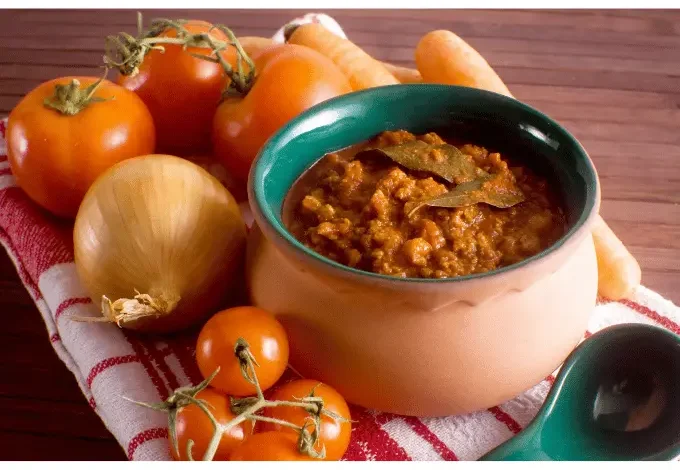BISON RAGU

Welcome to the savory world of Bison Ragu! We will explore the rich flavors and simple steps to create this hearty Italian dish. From selecting the perfect ingredients to mastering the cooking process, join us on a culinary journey to craft a satisfying meal that will delight your taste buds.
Essential Ingredients and Their Substitutions
Ingredients
Bison Ragu is a dish that celebrates robust flavors while embracing simplicity. Here’s a breakdown of the essential ingredients you’ll need to create this delectable dish:
- Bison Meat: The show’s star, Bison Meat, offers a lean yet flavorful alternative to traditional beef. Its rich taste adds depth to the ragu sauce.
- Pancetta: This Italian bacon brings the ragu a savory and slightly salty flavor. If unavailable, use bacon as a substitute.
- Vegetables: Onions, carrots, and celery form the aromatic base of the ragu sauce, providing sweetness and complexity.
- Tomato Paste and Crushed Tomatoes: These tomato-based ingredients contribute acidity and richness to the sauce, creating a well-balanced flavor profile.
- Red Wine: A dry red wine adds depth and complication to the ragu sauce. If preferred, beef or vegetable broth can be a non-alcoholic alternative.
- Herbs and Spices: Bay leaves, thyme, and rosemary infuse the ragu with aromatic notes, while salt and pepper enhance its overall taste.
- Pasta: Choose a pasta shape that can hold the hearty ragu sauce well, such as pappardelle or rigatoni.
- Parmesan Cheese: Grated cheese adds a final touch of umami and creaminess to the finished dish.
Substitutions and Ingredient Notes
- Beef can be substituted for bison meat if unavailable, though it will impart a slightly different flavor.
- If pancetta is not accessible, bacon can be used as a substitute, though the flavor profile may vary slightly.
- For a vegetarian version, omit the pancetta and use vegetable broth instead of beef.
- Customize the ragu with additional vegetables, such as bell peppers or mushrooms, for added depth and texture.
- Adjust the seasoning according to personal preference, taste it, and add more salt, pepper, or herbs as needed.
By understanding the role of each ingredient and its potential substitutions, you can confidently embark on the journey of creating Bison Ragu that suits your taste preferences and dietary needs.
Step-by-Step Guide on Making Bison Ragu
Creating a sumptuous Bison Ragu involves a series of simple yet crucial steps. Let’s dive into the detailed process of making this hearty dish:
Step 1: Preparing Pancetta and Vegetables
- Start by finely chopping onions, carrots, and celery, commonly known as mirepoix, to create the flavorful base of the ragu sauce.
- Dice pancetta into small pieces, ensuring it will render its fat and add depth of flavour to the sauce.
- Heat olive oil in a large Dutch stove or heavy-bottomed pot over medium intensity. Add pancetta and cook until it turns golden and releases its fat.
- Add chopped onions, carrots, and celery to the pot, sautéing until they become tender and fragrant, usually for about 5-7 minutes.
Step 2: Browning the Bison Meat
- Increase the heat to medium-high and add the ground bison meat to the pot, breaking it apart with a wooden spoon.
- Cook the bison meat until it browns evenly, stirring occasionally to ensure even cooking and caramelization.
- Season the meat with salt, pepper, and other herbs or spices to enhance its flavour.
Step 3: Simmering the Sauce to Perfection
- Once the bison meat is brown, add tomato paste to the pot, stirring to incorporate it into the mixture.
- Pour in crushed tomatoes and red wine, allowing the flavours to meld together as the sauce simmers.
- Toss bay leaves, thyme, and rosemary to infuse the sauce with aromatic notes, adjusting the seasoning to taste.
Step 4: Combining the Sauce with Pasta
- While the sauce simmers, cook pasta according to package instructions until al dente. Conserve some pasta water before draining.
- Remove the bay leaves and thyme sprigs once the ragu sauce reaches your desired consistency, and the flavours have melded.
- Toss the cooked pasta in the pot with the ragu sauce, adding reserved pasta water as needed to loosen the sauce and coat the pasta evenly.
- If desired, serve the Bison Ragu hot, garnished with grated Parmesan cheese and fresh herbs.
By following these step-by-step instructions, you’ll be able to master the art of making Bison Ragu, creating a dish that will impress families and guests alike with its robust flavours and comforting appeal.
Tips for Reheating Bison Ragu
Reheating Bison Ragu allows you to enjoy its delicious flavours again and again. Here are some tips to ensure that your reheated ragu remains just as flavorful and satisfying as when freshly made:
Stovetop Reheating
- Transfer the desired amount of Bison Ragu to a saucepan or skillet.
- Heat the ragu over medium heat, stirring occasionally to prevent sticking and ensure even heating.
- Add a splash of water or broth to loosen the sauce if it appears too thick.
Microwave Reheating
- Place the desired portion of Bison Ragu in a microwave-safe container with a lid.
- Microwave the ragu on medium power in 1-minute intervals, stirring in between, until heated through.
- Cover the container with a damp paper towel to prevent splatters and maintain moisture.
Oven Reheating
- Preheat your oven to a low temperature, around 300°F (150°C).
- Transfer the Bison Ragu to an oven-safe dish, cover tightly with foil, and place it in the preheated oven.
- Heat the ragu for 15-20 minutes or until warmed through, stirring occasionally to ensure even heating.
Avoid Overheating
- Be cautious not to overheat the ragu, as this can cause it to dry out and lose flavour.
- Heat the ragu gently and slowly to preserve its texture and taste.
Add Fresh Ingredients
- Add fresh herbs, such as parsley or basil, to the reheated ragu to enhance its aroma and freshness.
- A sprinkle of freshly grated Parmesan cheese can also flavour the dish.
Store Properly
- Store any leftover Bison Ragu in an airtight container in the refrigerator for 3-4 days.
- Alternatively, portion the ragu into freezer-safe containers and freeze for more extended storage, up to 3 months.
Following these simple tips ensures that your reheated Bison Ragu maintains its delicious taste and texture, allowing you to enjoy this comforting dish whenever the craving strikes.
Commonly Asked Questions (FAQs)
Certainly! Here are some frequently asked questions (FAQs) about bison ragu:
What is bison ragu?
- Bison ragu is a savoury Italian dish made with ground bison meat simmered with tomatoes, herbs, and aromatics to create a rich and flavorful sauce. I served over pasta, polenta, or creamy mashed potatoes.
How does bison ragu differ from traditional beef ragu?
- Bison ragu is similar to the conventional beef ragu but has a leaner and slightly sweeter flavour than beef. Bison meat is also lower in fat and cholesterol, making it a healthier alternative.
Where can I find bison meat to make ragu?
- You can find Bison meat at speciality butcher shops, some grocery stores, or online retailers. Ensuring the bison meat you purchase is high quality and sourced from reputable sources is essential.
Can I use ground beef instead of bison for ragu?
- Use ground beef if you can’t find bison meat or prefer beef. However, remember that the flavour and nutritional profile will be slightly different.
What are some recommended side dishes to serve with bison ragu?
- Typical side dishes to serve with bison ragu include pasta (such as spaghetti or pappardelle), polenta, mashed potatoes, or crusty bread. A side salad or roasted vegetables also complement the dish nicely.
Can I make bison ragu ahead of time?
- Bison ragu improves in flavour when made beforehand, allowing the flavours to meld together. You can store it in the refrigerator for 3-4 days or freeze it for extended storage. Warm it tenderly on the burner when prepared to serve.
Is bison ragu gluten-free?
- The essential ingredients of bison ragu (bison meat, tomatoes, herbs, and vegetables) are naturally gluten-free. However, check for gluten-containing additives if you use store-bought tomato products or add other ingredients.
Can I customize the seasonings in bison ragu?
- Absolutely! Feel free to change the seasonings to your taste inclinations. You can add extra herbs like rosemary or thyme, spices like chilli flakes for heat, or even a splash of red wine for depth of flavour.
Is bison ragu a healthy dish?
- Yes, bison ragu is considered a healthy dish due to the lean nature of bison meat and the abundance of vegetables and herbs used in the sauce. It’s a good source of protein, vitamins, and minerals while being lower in fat and cholesterol than beef ragu.
Can I use bison ragu in other recipes besides pasta?
- Certainly! Bison ragu is versatile and used in various recipes. You can use it as a filling for lasagna and stuffed peppers or a topping for pizza or baked potatoes. It’s also delicious served over rice or quinoa for a grain bowl.
Detailed Recipe for Bison Ragu
Creating a mouthwatering Bison Ragu requires attention to detail and a few key ingredients. Here’s a comprehensive recipe that will guide you through the process, ensuring a flavorful and satisfying outcome:
Equipment
- Large Dutch oven or heavy-bottomed pot
- Wooden spoon or spatula for stirring
- Knife and cutting board for chopping vegetables
- Measuring cups and spoons
- Pasta pot and colander
Ingredients
- 1 pound (450g) ground bison meat
- 4 ounces (115g) pancetta, diced
- One medium onion, finely chopped
- Two carrots, finely chopped
- Two celery stalks, finely chopped
- Three cloves garlic, minced
- Two tablespoons of tomato paste
- 1 (28-ounce) can crushed tomatoes
- 1 cup dry red wine
- Two bay leaves
- One teaspoon of dried thyme
- One teaspoon of dried rosemary
- Salt and pepper to taste
- 12 ounces (340g) pasta, such as pappardelle or rigatoni
- Grated Parmesan cheese for serving
- Fresh parsley or basil for garnish (optional)
Instructions
- Prepare the Vegetables: Finely slash the onion, carrots, and celery. Mince the garlic cloves.
Cook the Pancetta and Vegetables
- Heat a tablespoon of olive oil over medium heat in a large Dutch oven.
- Add the diced pancetta and cook until brilliant and firm, around 5 minutes.
- Add the chopped onion, carrots, and celery to the pot, sautéing until softened, about 7-8 minutes.
- Mix in the minced garlic and cook for 1-2 minutes.
Brown the Bison Meat
- Increase the heat to medium-high and add the ground bison meat to the pot.
- Break it apart with a wooden spoon and cook until browned, stirring occasionally, about 8-10 minutes.
- Season the meat with salt, pepper, dried thyme, and rosemary.
Add Tomato Paste and Crushed Tomatoes
- Stir in the tomato paste until well combined with the meat and vegetables.
- Pour in the crushed tomatoes and red wine, scraping any browned bits from the bottom of the pot.
- Add the bay leaves and mix to combine.
- Simmer the Sauce: Reduce the heat to low and let the sauce simmer, uncovered, for about 45 minutes to 1 hour, stirring occasionally, until thickened and flavors have melded. Taste and change seasoning with salt and pepper as needed.
Cook the Pasta
- While the sauce simmers, bring a large pot of salted water to a boil.
- Cook the pasta as per pack guidelines until it is still somewhat firm.
- Conserve a cup of pasta water before draining.
Combine Sauce with Pasta
- Once the sauce has reached your desired consistency, remove the bay leaves.
- Add the cooked pasta to the pot with the ragu sauce to cover the pasta equitably.
- If the sauce is excessively thick, add saved pasta water to release it.
Serve
- Divide the Bison Ragu among serving plates or bowls.
- Garnish with grated Parmesan cheddar and new parsley or basil, if desired.
- Serve hot and appreciate!
Notes
- For a vegetarian version, omit the pancetta and use vegetable broth instead of red wine.
- Customize the ragu with additional vegetables or herbs according to your preference.
- Store any extras in a sealed shut holder in the fridge for 3-4 days or freeze for more extended capacity. Reheat gently on the stovetop, microwave, or oven before serving.
With this detailed recipe, you can create a delicious Bison Ragu that will impress your family and friends. Enjoy the rich flavours and comforting warmth of this classic Italian dish!
Conclusion
In conclusion, Bison Ragu is a comforting and flavorful dish that brings together tender bison meat, aromatic vegetables, and rich tomato-based sauce. Following this article’s detailed recipe and tips, you can confidently embark on the culinary journey of creating a delicious Bison Ragu in your kitchen. Whether enjoyed as a cosy weeknight dinner or served to guests on special occasions, this hearty Italian dish will surely delight the senses and leave everyone craving more. So gather your ingredients, roll up your sleeves, and get ready to savour the rich flavours and comforting warmth of Bison Ragu.
MORE RECIPES
For more Italian recipes, now visit;




